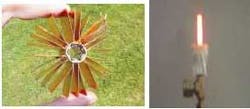Miniature power generator converts infrared to electricity
Thermophotovoltaic (TPV) devices are similar to ordinary photovoltaic devices in concept and form, except that TPV devices produce electricity from IR as well as visible light. Although this distinction may seem only incrementally important, it means that a TPV device can capture useful power from thermal emitters glowing no more than a dull red or orange, opening up the use of a legion of radiation sources fired by combustion (TPVs have even been made into wood-fired electrical power sources for third-world countries).
Researchers at the National University of Singapore and California State Polytechnic University (Pomona, CA) have now developed a miniature TPV power generator that may one day power micromotors, miniature vehicles, and portable electronic devices.1 Integral to the generator is an optical coating that recycles photons with energies that fall below the TPV cell's bandgap, thus boosting its efficiency.
Hydrocarbon fuels contain far more energy per unit mass than any battery. This fact has already spurred consumer-electronics giant NEC (Tokyo, Japan) to develop a fuel cell (which is not a TPV device) for laptop computers that is powered by a half-pint or so of methanol. The miniature TPV power generator developed by the Singapore and California group is powered by hydrogen gas.
The TPV generator consists of three components. The microcombustor is made of silicon carbide (SiC) and is 16 mm in length and 3 mm in diameter; a process within the cylinder enhances gas mixing (see figure). The emissivity of SiC is high across a broad wavelength band. At a hydrogen flow rate of 4.2 grams per hour and a hydrogen-to-air ratio of 0.9, the microcombustor reaches an average operating temperature of 1325 K.
The TPV cells contain gallium antimonide as the semiconductor, which responds to IR light out to a 1.8-µm wavelength. The fabrication process for these cells uses inexpensive diffusion steps without any toxic gases. Six planar cells, each 4.5 × 18 mm, form a cylindrical tube and have an internal quantum efficiency of 90% from 0.9 to 1.55 µm, which drops to 0.55 at shorter wavelengths and gradually to zero at longer wavelengths.
The photon-recycling dielectric coating has nine alternating layers of silicon and silicon dioxide on a glass substrate and recycles photons in the 1.8- to 3.5-µm band, while transmitting thermal photons with wavelengths shorter than 1.8 µm. The 1.02-mm-thick filters are bonded to the tops of the TPV cells with silicone.
The complete device produces 1.02 W of electric power. Because the device is the first prototype, many improvements can be made. For example, lengthening the combustor, filters, and cells will increase power. A combustor surface with a wavelength-specific emissivity, rather than the broadband characteristic of the SiC surface, will greatly boost power; candidate coatings are rare earth materials such as erbia and ytterbia. A good matched-emitter surface could increase the power of a slightly lengthened TPV device to 5.5 W.
"The micro-TPV power generator can be incorporated into microairplanes, microrobots, and microrovers," says Wen Ming Yang, one of the Singapore researchers. "In our future design, a microthruster will be incorporated into the micro-TPV power generator so that it can coproduce electrical power output and thrust, which will be an ideal power source for microairplanes. Furthermore, the device can also be used to power laptop computers."
REFERENCE
- W. M. Yang et al., Appl. Phys. Lett. 84 (May 10, 2004).

